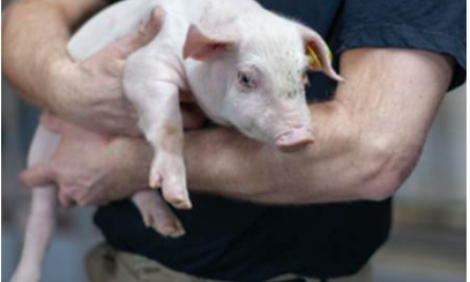



Research Update: Enrichment Devices for Nursery and Grower-Finisher Pigs
The results of the latest tests by Ontario Veterinary College of a variety of pig toys in nursery and grower-finisher pens were presented at the 33rd Centralia Swine Research Update.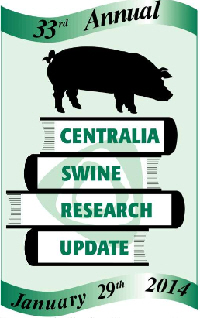
Study Objectives
Environmental enrichment for growing pigs has received increased attention in the last few years in modern swine-producing countries, according to Heather Neureuther of Ontario Veterinary College and co-authors there and OMAF and MRA. Enrichment devices are designated as necessary in the most recent draft of the Canadian Code of Practice for the Care and Handling of Pigs.
Many Ontario swine producers have been incorporating enrichment devices into their pig pens for years. Items such as hanging chains, tyres, bowling balls, and straw are commonly used. These objects, however, may not be the most durable or practical for environmental enrichment.
The purpose of this study was to gather information regarding what constitutes a preferred enrichment device by testing a variety of pig toys in nursery and grow-finisher pens.
Pilot Project
The initial pilot project for this study compared a rooting style toy to a teeter-totter style toy (Figure 1).
These toys were installed on several farms and producers recorded the number of pigs playing with each toy twice daily. Initial data showed much higher pig interest in the teeter-totter than the rooting toy. This difference in usage may have been due to the observation that the rooting toys became contaminated with faeces and urine, which may have discouraged pig interactions.
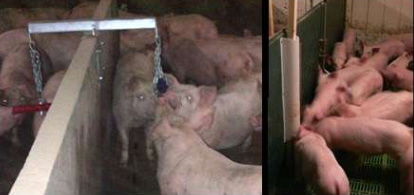
The focus of the project then switched to the teeter-totter and the number of pigs that demonstrated sustained interest in playing with this toy. Preliminary analyses showed that farms had the most pigs playing with the toys during the first week after installation. Most farms saw a 30 to 50 per cent decrease in toy use in the second week of the study. For the remainder of the four month observation period toy use remained relatively stable with only one or two days a month when no pigs were recorded as playing with the toy.
This pilot project demonstrated that pigs will consistently play with some types of toys over several months.
The project also revealed some problems with the study and toy design.
Problems related to toy design included: pigs getting their heads stuck in the chains of the toy attachment, pigs destroying the toys, and toys falling off the teeter-totter. These events resulted in producers having to spend time fixing the toys and ensuring pig safety, which were detrimental to the practical application of the devices in commercial settings.
In addition, questions arose with respect to the design of the study including:
- Do all the pigs in the pen play with the toy or only a few?
- Would toys that produce noise increase pig interest?
- Are there superior styles of toys available for swine environmental enrichment?
In an attempt to address these questions, a second pig toy study was undertaken.
Current Pig Toy Research
The second swine environmental enrichment study began in Fall 2013. This study used the same format as the initial project. Farmers recorded the number of pigs playing with each toy every morning and afternoon for a four month period, but compared four different styles of toys: teeter-totter with a bell, teeter-totter without a bell, tri-star with a bell, and tri-star without a bell (Figure 2).
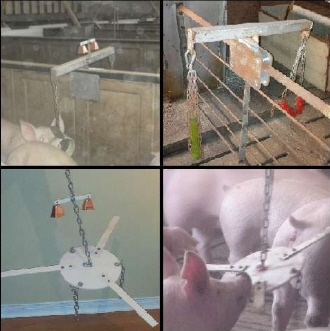
tri-star without bell and tri-star with bell
The teeter-totter toy is the same style as the original study (having toy attachments that are wood, KONG dog toys, or PVC pipe).
The tri-star is a plastic circle with three plastic arms and hanging chains, which can be hung from the ceiling of the room. Half of the toys have a bell attached to test whether pigs play more with toys that make noise.
So far, the data, as well as input from the producers, suggest that there are more pigs playing with the tri-star toys. This may be due to more pigs being able to access the tri-star from all sides. While the tri-star may be more popular, it is also more destructible. On several farms finisher pigs have completely chewed away the plastic arms within a month of installation.
The teeter-totter appears to be more durable but it, too, is not fully indestructible (Figure 3).
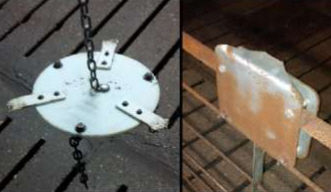
and teeter-totter broken off attachment plates (right)
The fact that the tri-star’s arms can be chewed may also increase pig interest, as pigs are more attracted to materials they can manipulate. Producers report that the bells do not appear to influence pigs’ interest in the toys.
The next part of this study involves marking pigs in the pen with a unique identification number and observing if the same pig always plays with the toy or if different pigs in the pen take turns playing. The data and information gathered from this swine environmental enrichment study will be valuable in understanding how pigs play, interact with enrichment devices, and the types of objects with which they prefer to interact.
Reference
Neureuther H., P. Canning and T. Blackwell. 2014. Research update: Enrichment devices for nursery and grow-finisher Pigs. Proceedings of 33rd Centralia Swine Research Update. II-25–II-26.
June 2014







